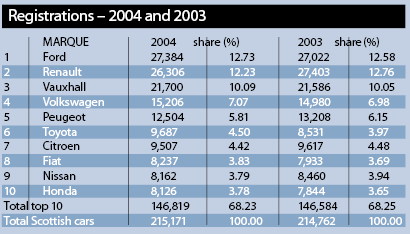The Scottish Motor Traders Association (SMTA) recognises that in order to fully help its members, it must be more than a sign above the door: it needs to offer solutions to their problems. Five years ago, membership reached its nadir when penetration of Scotland’s 650 retail outlets dropped to 70%. That’s when chief executive Douglas Robertson joined. He recognised the SMTA was too reliant on the Scottish Motor Show for revenue and needed to deliver greater value.
"Our role had to change dramatically," Robertson says. “We had to move from being an association to a provider of services."

A year ago, the SMTA set up the Trading Partners buying group, while its Scotsure used car warranty and GAP insurance scheme, which has more than 1,200 policyholders, is turning useful profits while providing members with added value.
The Scottish Motor Show, meanwhile, was licensed in 2002 to SECC and while that contract ends in 2006, it’s unlikely the association will take back full responsibility. "We will see what we can do with it, but motor shows have changed – they need to be much more interactive and we need to get dealers involved," says Robertson.
The SMTA is now self-sufficient and has broken even for the past three years. Membership stands at more than 530 franchised outlets (83% of the Scottish market) and 415 independents, and continues to grow.
"We think there is great potential to bring more independents into membership," says Robertson. "There’s probably around 1,200-1,500 independent companies in Scotland that should be SMTA members."
Arguably the SMTA’s biggest contribution is the apprenticeship scheme. It started in 2000 with 31 apprentices and now has more than 200, expected to rise to 230-240 with the new intake in September. But it’s not been an unqualified success.
"A lot of people were signing up late in August and September – they’d tried everything else and it was a last option – and they were dropping out in December to go and stock shelves in the supermarket," says Robertson.
To address the problem, and raise the industry’s image with school-leavers, the SMTA this year set up a pilot pre-apprenticeship course. This 26-week programme, funded by Grampian Motor Training Trust, encourages employers to take on teenagers aged 15+ on Saturday mornings, paying them £10 plus travel expenses.
"The idea is to see if we can change their attitude and make the motor trade their first choice occupation," says Robertson.
Twenty-four employers have taken on 28 teenagers, and the SMTA has a waiting list of participants.
"We’d like to get the Scottish Executive involved and use this scheme as the template for Scotland," adds Robertson.
More recently, the SMTA has embarked on a member referendum. It wants to gauge views on licensing, pre-empting any legislative move by Government.
"Licensing is going to come – whether that’s in five, 10 or 20 years’ time. We need to know which side of the fence we should be on when we negotiate with legislators in the future," Robertson says.
Top sellers 2003-2004
Renault has a much bigger slice of the Scottish market compared to in England. Historically it has been a big supporter of the Scottish Motor Show and has large showrooms, with significant representation by Arnold Clark and Reg Vardy. Profitable franchises at the moment include BMW/Mini and Audi (Scotland is its biggest market in the UK).














Login to comment
Comments
No comments have been made yet.